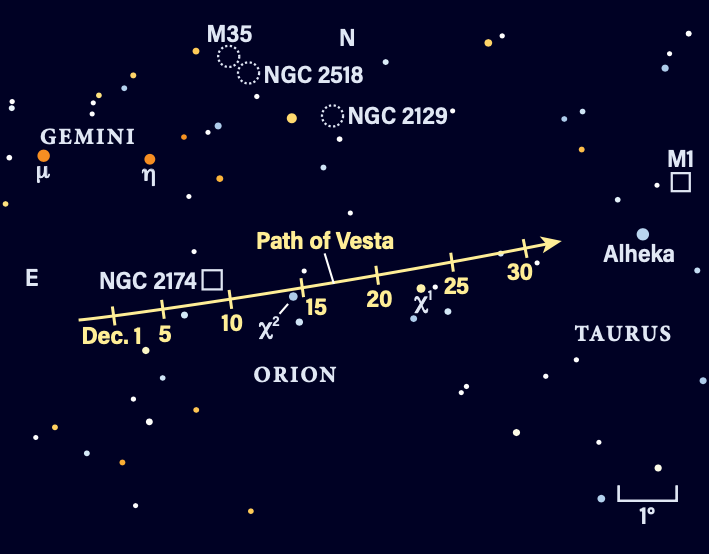
Catch a glimpse of innermost planet Mercury soon after sunset in early December. Once darkness falls, you’ll find Saturn descending in the south and Jupiter high in the east. Both are ideally located for easy telescopic views in the early evening. Jupiter is near its best for the year and you’ll have many hours to watch its rotating cloud belts until well after midnight. Uranus and Neptune remain within reach of binoculars, while Venus lights up the morning sky, rising a few hours before dawn.
Mercury stands 6° high 30 minutes after sunset on Dec. 1. Shining at magnitude –0.4, you’ll find it low in the southwest. It sets within another 40 minutes. This narrow window improves slightly by the 4th, when Mercury achieves its greatest eastern elongation from the Sun at 21° east of our star. It’s gained nearly 1° of altitude 30 minutes after sunset, giving you an extra five minutes of observing time. A close-up view with a telescope reveals a 62-percent-lit gibbous disk on the 4th, which diminishes to just over 50 percent lit by the 7th.
Mercury fades to magnitude 0 by Dec. 11, maintaining a similar altitude above the southwestern horizon, but after this date it drops quickly and dims further, down to magnitude 0.7 by the 15th. Soon after this, you’ll lose sight of the small planet. Mercury reaches inferior conjunction on the 22nd.
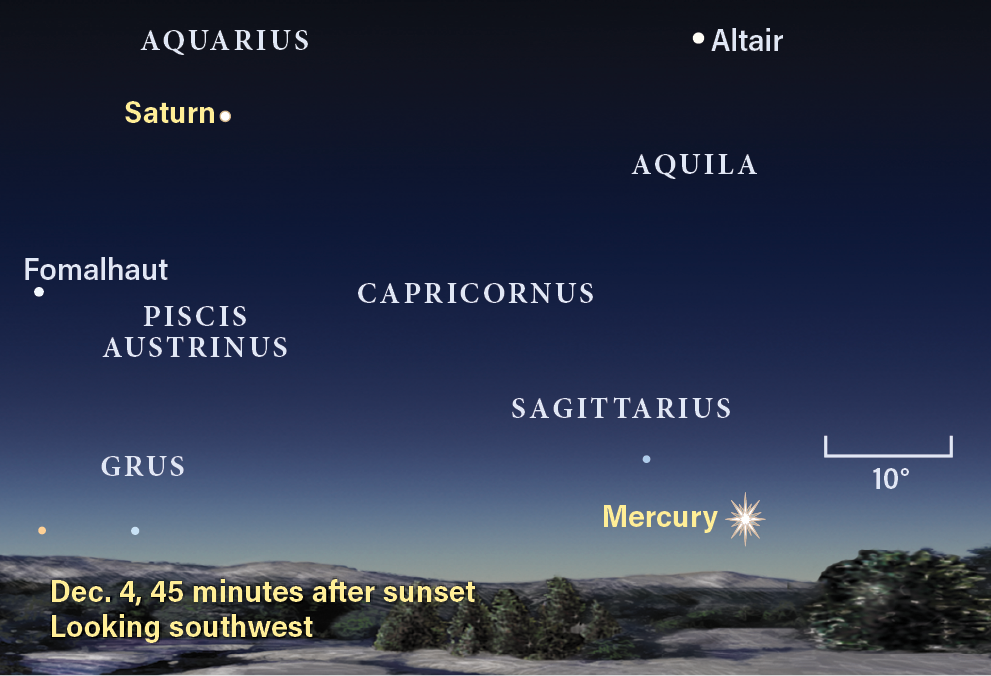
Saturn is well placed high in the southern sky as twilight falls. Plan your viewing in the early evening, as it sets by 9 p.m. local time at the end of December. The ringed planet is located in southwest Aquarius about 20° above and to the west of Fomalhaut, the only 1st-magnitude star sitting lower in the southern sky. A beautiful five-day-old crescent Moon stands 3° south of Saturn on the 17th.
Saturn glows at magnitude 0.8 to 0.9 this month and is receding from Earth after its opposition in August. By mid-December, it lies 10 astronomical units (930 million miles; 1 astronomical unit is the average Earth-Sun distance) from Earth. Through a telescope, its disk spans 16″ and the major axis of the rings stretches 38″ early in December, diminishing to 36″ by the end of the month. The tilt of the rings to our line of sight drops to 9°, allowing clear views of most of the planetary disk.
Titan is the brightest of Saturn’s moons. Spot it shining at magnitude 8.7 standing roughly north of the planet Dec. 12 and 28, and roughly south Dec. 4 and 20.
Tethys, Dione, and Rhea are also observable in small telescopes inside the orbit of Titan. All shine at 10th magnitude and constantly change position from night to night.
Tethys undergoes regular transits but with the narrow observing window, few are visible. One occurs early in the evening on Dec. 7th and again on the 24th. The following are approximate times; plan to be observing 15 to 20 minutes before the start. Tethys begins transiting at about 8:40 p.m. EST on the 7th and crosses for 90 minutes. On the 24th, the event begins around 8:27 p.m. EST and lasts about 108 minutes. It’s difficult to see the moon visually because the bright disk of the planet hides it. The events are best recorded with high-speed video cameras designed for planetary observation.
Iapetus is just past its brighter western elongation in late November and moves closer to Saturn from our perspective, reaching superior conjunction Dec. 18. On Dec. 2, a 9th-magnitude field star lies 6′ west of Saturn and Iapetus stands 3′ southwest of this star, aiding with identification of this faint moon, shining at magnitude 10.5. Follow it toward superior conjunction, when it stands 24″ southeast of the planet’s center.
Neptune is visible all evening, though it sinks very low in the west before midnight, so catch it early. It shines at magnitude 7.7 to 7.8, requiring binoculars to view it. Neptune lies on the border of northeast Aquarius and southwest Pisces, just south of the Circlet asterism in Pisces. You’ll find it 5° due south of magnitude 4.5 Lambda (λ) Piscium, the southeasternmost star in the Circlet. Magnitude 5.5 20 Piscium lies about 1.5° east-northeast of the planet. A First Quarter Moon sits nearby on Dec. 18 and 19.
The planet lies some 29.9 AU (2.8 billion miles) from Earth, its tiny bluish disk spanning 2″ at that distance. Neptune’s retrograde motion ends in early December and it barely moves against the background stars all month.

Jupiter is visible nearly all night and continues its retrograde path through Aries the Ram. It fades slightly from magnitude –2.8 early in the month to magnitude –2.6 by the 31st. The planet is a spectacular object and is joined by a gibbous Moon Dec. 21 and 22.
Through a telescope, Jupiter’s disk is readily visible, spanning 48″ on Dec. 1 and shrinking to 44″ by month’s end. With Jupiter climbing higher in the sky than it has been since 2015 for northern observers, it garners a lot of attention. Any telescope shows Jupiter’s pair of dark equatorial belts straddling the equator. The Great Red Spot makes regular appearances, along with more subtle detail visible with patient viewing. Watch for stable moments of air for the clearest views, which create random occasions when detail is breathtaking.
Adding to the spectacle, the four bright moons undergo transits and occultations. At opposition, transiting moons and their shadows nearly overlap, while afterward the moon leads its shadow. Now that we’re a month-plus past opposition, moons are followed much later by their accompanying shadow.
Highlights to watch for this month include a series of Io transits on Dec. 6, 13, 20, and 27/28. On the 6th, the transit occurs early in the evening, with subsequent events beginning progressively later each time. Europa transits occur in a similar series on Dec. 5, 12, and 19, again transitioning from an early evening start to progressively later times.
Ganymede transits the southern polar region of Jupiter Dec. 1 starting at 10:19 p.m. EST and finishing at 11:45 p.m. EST. It repeats the transit Dec. 8/9, beginning at 1:42 a.m. EST (Dec. 9 in EST and CST, still the 8th in more western time zones) and ending 92 minutes later.
A pair of events occurs Dec. 26/27 as Europa approaches a transit late in the evening. Minutes after 12 a.m. EST on the 27th (the 26th in all other U.S. time zones), Ganymede reappears from behind Jupiter’s northeastern limb — watch for 10 minutes as the growing brightness of the moon becomes apparent. The Europa transit begins about 90 minutes later, just before 12:30 a.m. CST on the 27th (again, still the 26th for the western U.S.). And less than two hours later, Ganymede disappears again, as the large moon goes into eclipse inside Jupiter’s extended shadow.
Uranus is visible late into the night and is only a month past opposition. It stands roughly midway between Jupiter and the Pleiades star cluster (M45). Located about 9° southeast of M45 is a small group of stars shining between 4th and 6th magnitude. Delta (δ) Arietis is brightest, and a useful signpost to find Uranus. The bluish-green planet, glowing at magnitude 5.7, lies between 2° and 3° south-southwest of this star during December. Uranus travels westward as its retrograde path continues, carrying it farther from Delta. The planet stands 18.8 AU (1.75 billion miles) from Earth; through a telescope, it shows off a tiny 4″-wide disk.
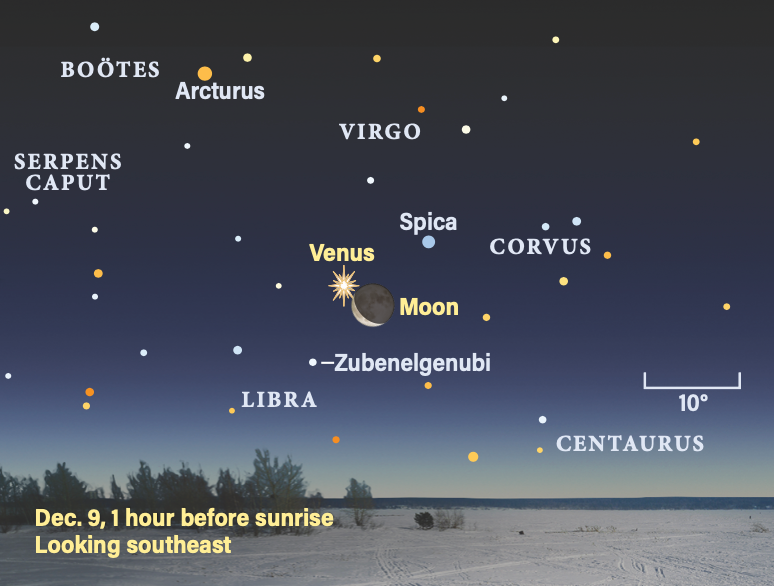
Venus rises shortly before 4 a.m. local time with the stars of Virgo in early December, standing 4.5° northeast of Spica. As it approaches the border with Libra, you’ll find a lovely 26-day-old crescent Moon some 4° south of Venus on Dec. 9. Two days later, Venus crosses into Libra, passing less than 2° north of Zubenelgenubi (Alpha [α] Librae) on the 17th. With Venus now at magnitude –4.1, it’s a brilliant sight, with 1st-magnitude Arcturus in Boötes shining 35° above the planet in the sky.
Venus continues across Libra and ends the month just short of Scorpius. It stands 10.5° above Antares, the Scorpion’s 1st-magnitude red giant, on Dec. 31.
Venus is receding from Earth. In a telescope, the disk shrinks from 17″ to 14″ during the month. The phase changes as well, growing from 68 percent lit on Dec. 1 to 78 percent lit by the 31st.
Mars is too close to the Sun to observe after its conjunction with our star last month.
Earth reaches its winter solstice Dec. 21 at 10:37 p.m. EST, when the Sun appears at its farthest south on the celestial sphere and begins its journey northward.
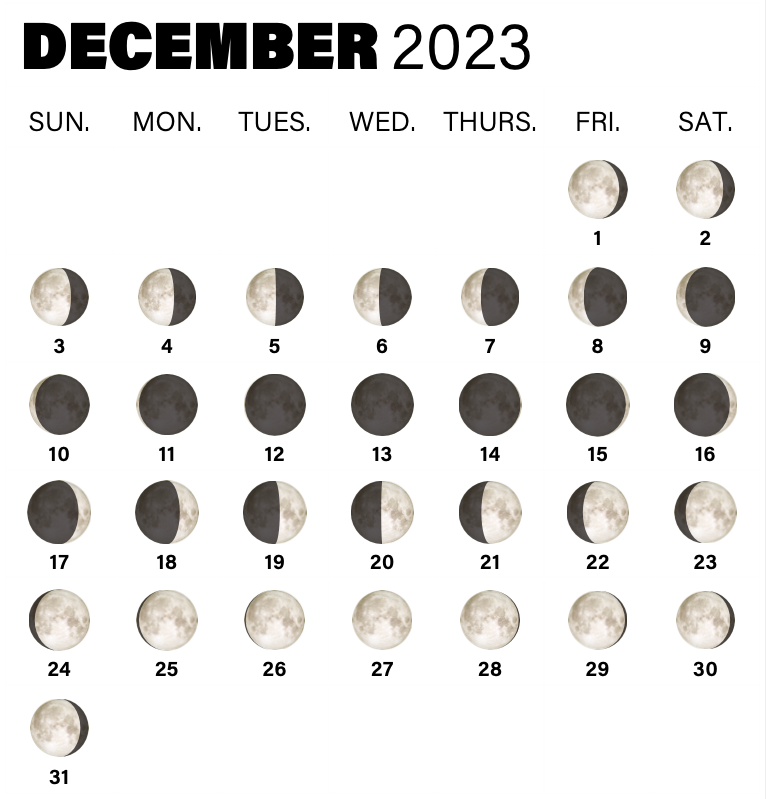
Rising Moon: Dancing with perspective
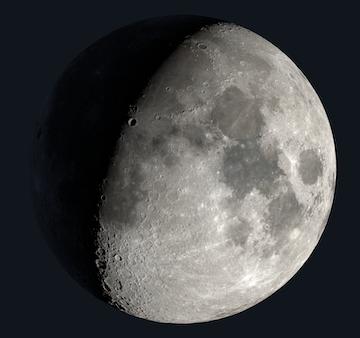
There’s more to the Moon than what’s on it. Every month, our sister Luna performs a subtle sway for all of us to see — if we know what to look for. This month, let’s concentrate on just one aspect of the movement: the dip and rise.
Turn the page to Paths of the Planets, where you can see the blue arc of the Moon swinging below and then rising above the red path of the Sun. This down-and-up motion is a result of the tilt of the Moon’s orbit relative to Earth’s. As the pair of us slowly twirl around the solar system’s dance floor, Luna’s head appears to rise and drop.
As a waxing crescent on the 16th, the Moon has dipped below us, the bright dimple of Furnerius tucked against the lower right of its face. With each passing day, Luna rises up and the dimple climbs away from the limb, and we see more under its “chin.”
On the 21st, we’re level eye to eye, when we can observe the first hints of the delicate tattoo of Mare Australis appearing at the southeast limb. The patchwork of darker markings is slowly revealed as the Moon becomes Full on the 26th. This southern sea is really part of a large farside basin partially filled with lava flows.
Luna has now reached the top of its move and slowly drops back down, but the change in the southeast now takes place in darkness, out of sight. Regular readers know I love the 3D shifting shadows near Mount Clementine at the south pole. Watch for these from the 24th to the 28th.
Meteor Watch: A sparkling show
A two-day-old Moon at the peak of the Geminid meteor shower makes this year’s event very favorable, with dark skies all night. They’re active from Dec. 4 to 17, peaking late on the 14th. The zenithal hourly rate, calculated for when the radiant is at the zenith, can reach over 100 meteors per hour. Soon after local midnight, with the radiant more than 65° high across the continental U.S., this results in peak rates above 50 meteors per hour, close to one per minute. This is as good as it gets for meteor watchers and is the best shower of the year. Settle back with warm clothes and a warm drink, and enjoy.
A second shower in December, the Ursids, peaks Dec. 22 just before midnight EST, but with far lower rates. It’s active from Dec. 17 to 26 and on good nights can produce a meteor every five to 10 minutes.
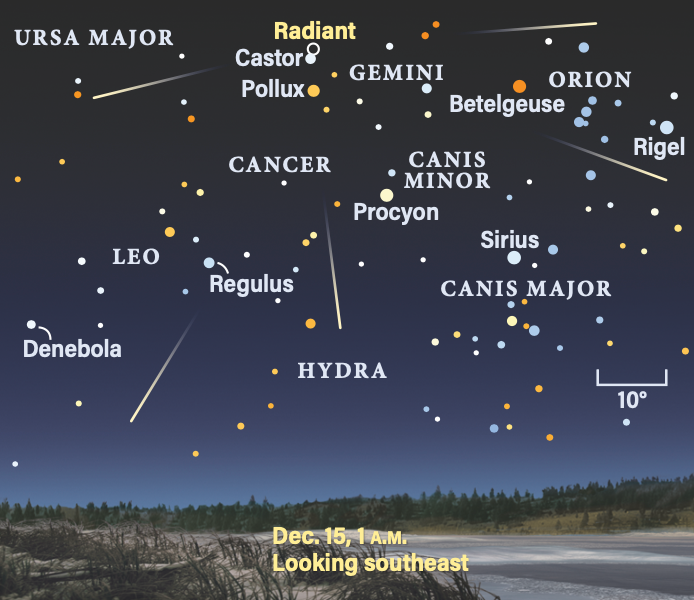
Comet Search: Good, but better to come
An 8th-magnitude comet rivaling the brightness of many Messier galaxies is a welcome sight in any size scope under dark skies. Knuckle down and stay up until 1 a.m. for 62P/Tsuchinshan 1 to rise in the east above blue-white Regulus, the heart of Leo.
Discovered in 1965, Tsuchinshan 1 returns every 6.2 years to a spot 25 percent farther from the Sun than Earth. This time, it comes closest to the Sun Dec. 25th. Its size is unknown, but it can’t be bigger than a mile because 7th magnitude is about as bright as it gets.
The dark-sky observing window opens on the 5th after midnight and before moonrise, and closes on the 17th as the waxing First Quarter Moon gets in the way. Imagers should shoot on the night of the 28th, when the greenish comet grazes the Leo Trio.
Itching for an evening comet? Try 12P/Pons-Brooks, now sliding past Vega. You’ll want an 8-inch scope to pick up the small 10th-magnitude fuzz — unless it repeats its July outburst. Keep going and you can tag 144P/Kushida as it floats between Jupiter and Uranus in Aries.
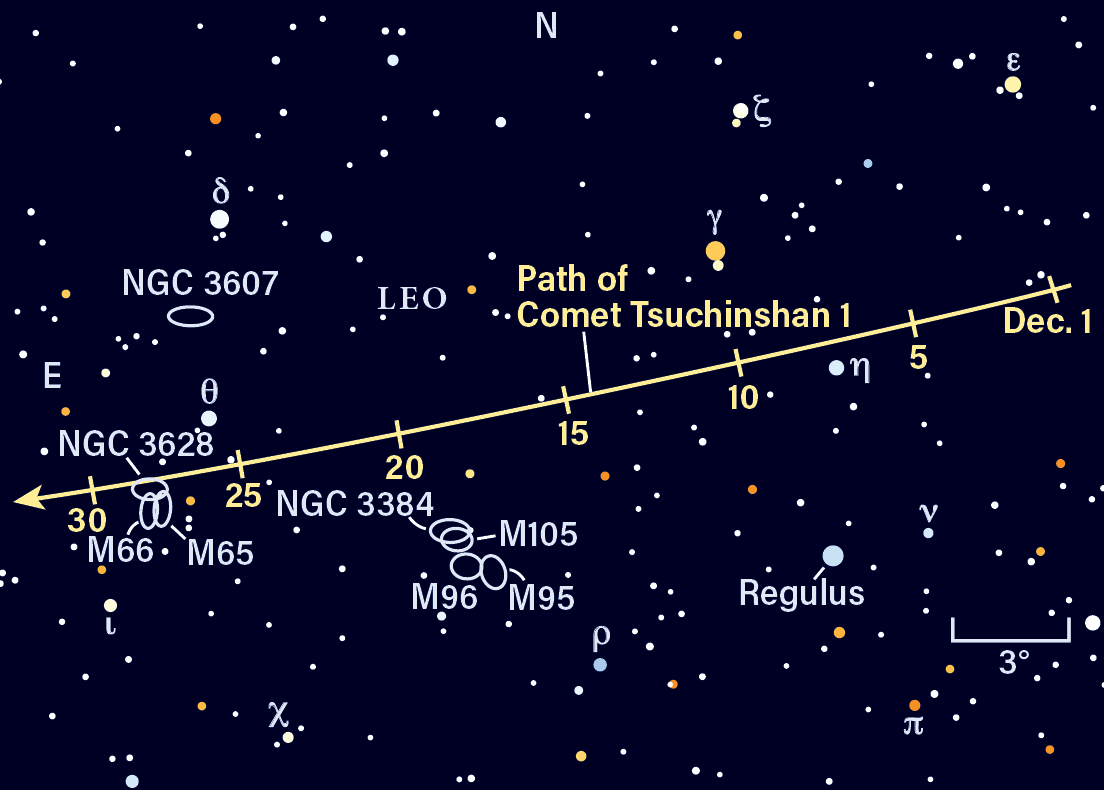
Locating Asteroids: Dash out for a quick catch
Easy asteroid tracking has returned with 4 Vesta hitting magnitude 6.4 on the 19th. From the suburbs with scarcely any dark adaptation, you can walk outside, point your binoculars at the feet of Gemini, shift half a field to the right, and spot the fourth- or fifth-brightest object. Even if it is cracking cold, it won’t take more than five minutes!
Copy our star chart or trace out the pattern of the brighter stars in a logbook, then each night you try, place a dot where you see Vesta. On the 7th, it lies just north of a brighter field star; it is tucked close to Chi2 (χ2) Orionis on the 14th and 15th. With any small scope at 80x, we can notice the space rock move over the course of three hours on the 29th as its position between two field stars shifts.
As the second-largest asteroid in the main belt, potato-shaped Vesta measures 330 miles across. Its reflectivity of 40 percent is four times that of our Moon, but half that of fresh snow.
